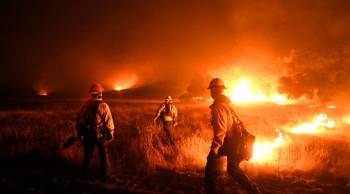The logistics of fighting massive wildfires
Share Now on:
The logistics of fighting massive wildfires
Wildfires are frighteningly common in California, and a four-year drought means they move even faster and demand even more attention. More than 13,000 firefighters are battling a dozen blazes statewide, which has already cost $28.9 million, according to the California Department of Forestry and Fire Protection (Cal Fire), a firefighting agency geared toward protecting California’s privately owned wildlands.
One of the largest is the Valley Fire, which has several firefighting agencies, including Cal Fire and local departments, combating the flames.
In a sweeping national disaster, with other fires burning across the region, how do groups stay coordinated? Federal Forest Service spokesperson Jennifer Jones says it’s all about “bottom-up” management.
Local units of federal agencies, local fire departments and state agencies have suppression resources they’re in charge of, such as firefighters, engines and equipment, that can be ordered through a local dispatch center, Jones says. When a wildfire arises, a fire manager or incident commander determines which assets will be needed to suppress it and can order those resources through the center.
There are three categories of responsibility: federal areas, which encompass forest land; state areas, which in California includes 31 million acres of private wildlands; and local areas, which are typically in cities or community services districts, says Dave Teter, a deputy chief for Cal Fire.
California’s mutual aid system, which allows all participating fire departments in the state to call departments outside of their jurisdiction for help, is integral to coordinating efforts, Teter says.
Each participating fire department has a “draw down” level — the number of resources, such as fire engines, it can devote to fires outside its jurisdiction, Teter says.
Teter adds that Cal Fire strives to make sure assisting departments can get released from fire combat if it starts to take a toll on their resources.
“We certainly work with our cooperators if they have a need to have their resources returned,” Teter says. “So we’re certainly not going to hold them hostage; we understand that needs change, and times change.”
Resources are mobilized as quickly as possible, Teter says, but there is lag time between identifying what kind of help is needed and delivering it.
“When you’re under duress and in a time of need, five minutes can seem like an eternity,” Teter says. “We hear that a lot from citizens, and we certainly understand when they are enduring a critical time in their life, minutes can seem like hours.”
As for the firefighters, work hours can be long and arduous — especially depending on the severity of the fire. Teter says Cal Fire tries to keep them on the fire line for no more than 14 days before giving them two days of rest, though that’s not always possible.
“But our goal is to continue to keep an eye on our firefighters … and then ultimately, get them back to their home locations, wherever that may be in the state, and actually get them some time off duty with their families,” Teter says.
There’s a lot happening in the world. Through it all, Marketplace is here for you.
You rely on Marketplace to break down the world’s events and tell you how it affects you in a fact-based, approachable way. We rely on your financial support to keep making that possible.
Your donation today powers the independent journalism that you rely on. For just $5/month, you can help sustain Marketplace so we can keep reporting on the things that matter to you.


















